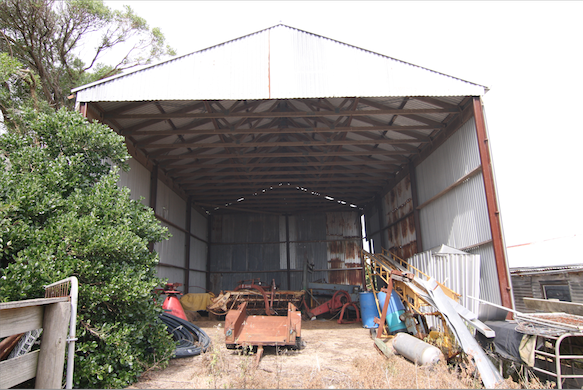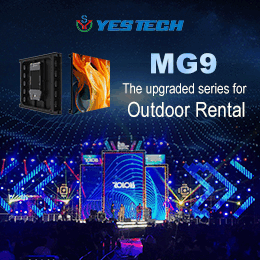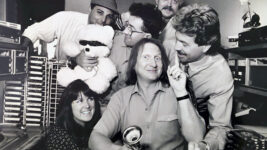Subscribe to CX E-News
To say ‘it’s all happening’ down here at The Mill would be an understatement of momentous proportions. I’ve been burning the candle at both ends lately, as well as trying to get the thing to light in the middle.
Between the several album projects I have on the go – not to mention the mastering of a new wave of vinyl releases (which seems very ‘in’ at the moment), and repairing faulty Neumann mics and Neve preamps – the studio is contemplating what so many others have at some point in their lifespan – a grand expansion.
To explain… what used to be my neighbour’s giant tractor shed right next door to the studio may be about to become part of The Mill. We’ve bought 118 acres next door you see, which includes all the farm sheds, a separate power source and paddocks as far as the eye can see. It’s a massive, somewhat unexpected shift in focus for me and my family, which has also dramatically called into question the current renovation plans I have for the studio.
TRACK TIME
The Mill has never been a full-on tracking studio. It was primarily designed for mixing and mastering, hence its very large production-style control room, and little else other than a machine room and small overdub booth.
There’s accommodation upstairs and a large lounge room behind the main space that gets pressed into tracking duties from time to time, but there has never been a large main tracking room per se. Not often, but occasionally, I really wish there was.
The original studio plans contemplated it at one stage, but in trying to stay within the confines of the original building footprint, a separate recording room would have compromised the size of the control room far too much. In the end I avoided cutting the space into too many tiny pieces, which frankly, was the best move I ever made.
Nearly all the recording gets done in the main production room anyway, but this has its strengths and weaknesses. There are times when I get royally sick of tripping over mic leads and headphones in and around the console. Tracking without being able to monitor via the speakers half the time can get quite annoying too.
But now plans are afoot to join the existing studio building to the shed next door – which is no more than about six metres away. It’s a decent sized building: 14 x 8 metres with a six metre gabled roofline. In reality it’s little more than a tin shed with decent roof trussing and a metal frame, but when the sun hits it at a certain angle and you’re drunk enough, the building looks like the perfect tracking space.
Originally I had no intention to expand The Mill like this. Frankly, there was no room for expansion anyway, nor funds to contemplate it. But a couple of things have changed down here that have led to the land purchase, and now, quite unexpectedly, the shed ‘next door’ is ours.
And what does any self-respecting producer/engineer with masters degrees in both pipe dreaming and economic suicide contemplate every time he sees an empty shed?
A studio.
The building is currently three sided, with a dirt floor and swallows nesting in the roof. But that’s exactly what The Mill studio building looked like before I moved here. In all honesty it’s the perfect blank canvas for a tracking space – it’s big and raw and right next door!
The trick will be to crunch the numbers – though I’m not sure what that means exactly – to see if we can honestly afford to convert the building into a viable <<and quiet>> tracking space. It’s a big area to renovate, no doubt requiring tens of thousands of dollars in labour and materials to bring online, but if we can pull it off it will be amazing.
STILL AIR
It’s one of the most important aspects of any decent recording studio – a large, good sounding space that’s <<quiet>>. Despite what some people may think, that’s what you pay for when you hire a decent recording studio – still air. Sure, the gear is important but it all counts for nothing if the main recording space is noisy.
But the problem with recording studios is that, historically, they’ve been at the most cost ineffective end of the production process. They generally occupy the largest space, require the most equipment and infrastructure and can charge the least amount of money per hour. Mastering meanwhile has generally been the most lucrative link in the production chain, earning those engineers more money per day from a generally smaller financial investment in terms of both equipment and floor-space. Mixing has been somewhere in between the two, often involving less equipment than a recording studio but typically more than a mastering suite (though there are exceptions to this generalisation).
But mixing rooms are rare as hen’s teeth nowadays, particularly in Australia. Off hand I can hardly think of one that’s not attached to a bigger studio complex, and I know why.
Things have changed dramatically in the last decade. ‘Production facilities’ – for want of a better phrase – like The Mill have grown exponentially in number, taking advantage of the rise and rise of vastly less expensive equipment, at the same time snapping up some of the older more expensive gear at a fraction of its original price.
These new facilities have invested far less in equipment than the older ones, which were unfortunately never able to pay off their gear before the tidal wave of cheaper stuff flooded the market. When the market flooded, earnings plummeted and businesses closed.
The new production spaces are typically owner/operator affairs run by highly skilled individuals who offers clients a wide variety of music and production tools to accomplish everything from song-writing and recording, right through to mixing and sometimes even mastering.
As this model has taken over, the shift from big studios to smaller ones has seen one-stop-shops develop, where basically everything is done in the one small facility.
In other words, it’s difficult in 2015 to be dedicated to one aspect of an audio production. People expect to be able to do their recording, mixing and, to a lesser extent, mastering in the one place. Not necessarily always the best approach, but it can certainly work out if the person running the show knows what he or she is doing.
But this scenario doesn’t feel particularly new… in many ways it’s the wheel coming full circle.
THE UNSTOPPABLE DREAM
So The Mill will in all likelihood be adding a big tracking room. Although the costs of building it may never be recovered in truth, my dreams for the space are quickly overrunning any economic rationality that might want to abort the mission. Time will tell what happens…
Meanwhile I’m rushing out the door right now to drive 2.5 hours across Victoria to an album launch for a band I produced 17 years ago called the Dead Salesmen. They’re the uncrowned kings of Ballarat and their album ‘Amen’ is being re-released on vinyl tonight (mastered by yours truly). It’s going to be a blast from the past and many of my friends and colleagues will be there to get drunk and sing along to some familiar tunes of yore.
Looking forward to it immensely… looking back.
Subscribe
Published monthly since 1991, our famous AV industry magazine is free for download or pay for print. Subscribers also receive CX News, our free weekly email with the latest industry news and jobs.












